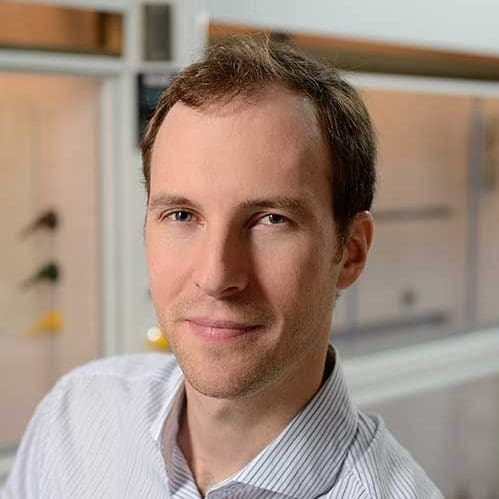Images courtesy of Thomas Kempa
Thomas Kempa sometimes thinks of himself and his lab members as artists whose medium is nano and quantum materials. Wielding chemistry as a tool, they sculpt their materials in ways that make them unique and useful in applications ranging from cryptography to sustainability.
An assistant professor of chemistry, Kempa works in what is known to insiders as the world of “flatland” materials—two-dimensional layers that are only a few atoms thick, but that can extend up to several millimeters in the x-y plane, like a sheet of paper. One area of focus for his lab is figuring out how to alter known 2D materials at the nano scale, thereby imbuing them with new properties. A second is making new 2D materials by assembling clusters of atoms into unfamiliar networks.

What makes us a bit different is that we’re more interested in the core properties of the materials and what we can do to make them special….The advantage of being applications-agnostic is that you end up making sure the material you’re proposing is really uniquely capable toward solving a problem.”
—Thomas Kempa
Kempa is mostly interested in learning everything he can about the materials’ varied properties by tailoring their size, shape, phase, and topology and expanding the flatland “kingdom” in the process. But as his understanding of the properties grows, possible applications for the materials begin to suggest themselves. Some materials reveal themselves to be efficient catalysts, converting less desirable molecular fuel to a more desirable form. Others can increase the efficiency of how charges or gas molecules are stored and released. Still others might support a next-gen type of computing that replaces transistor electronics with quantum spintronics.
Yet another material is created by snipping the 2D sheets into strips with atom-precise cuts. These strips are a step in the direction of making single photon emitters that operate in a controlled way, allowing them to function as the quantum bits that replace the 0-1 bits in conventional computers. These “qubits” make quantum computers possible, and can also revolutionize the sensitivity of sensors that measure things like pH, temperature, or even antibodies to viruses like the one that causes COVID-19.
Finally, in this age of big data, the vast amounts of information in constant flight raise security issues beyond the capacity of classical cryptography, says Kempa, who arrived at Hopkins in 2015 after doctoral and postdoctoral work at Harvard and MIT. Operating instantaneously, quantum cryptography—enabled by 2D materials—could prevent security breaches.
What makes us a bit different is that we’re more interested in the core properties of the materials and what we can do to make them special, and we’re kind of open-minded about whatever the material might be actually good for. The advantage of being applications-agnostic is that you end up making sure the material you’re proposing is really uniquely capable toward solving a problem.
Kempa has also been exploring an entirely different class of 2D materials with properties that can turn them into functional skins—something that might be used in a helmet that better dissipates mechanical energy to reduce the likelihood of brain injury, for example, or car bumpers and aircraft skins that can repair themselves after damage.
Kempa anticipates finding fulfillment following the path charted by his flatland materials for a long time to come, but there is one idea—related but with a twist—that he imagines pursuing in the not-too-distant future. Before finding his home in physics and chemistry, he thought he wanted to be a neurosurgeon.
“It would be super-exciting to get back to that early fascination of mine, and try to develop methods or materials that could help us understand the workings of the human mind,” he muses.







